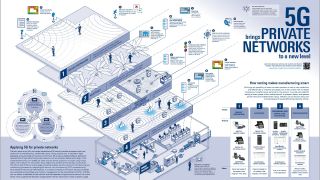Testing 5G private networks
Requirements for campus networks
Societies worldwide depend on the performance, reliability and security of critical infrastructures and networks. There are many “new verticals” or use cases in manufacturing, mining, warehouses and ports - among many others. These new use cases all have one common requirement: a network that provides a superior performance compared to commercial mobile networks. 5G private or campus networks provide the high performance that can increase productivity and efficiency for these new use cases.
Your 5G private network testing challenges
Wireless networks must be highly reliable if they are to be successful in business-critical use cases. Here are some examples of applications used in business-critical environments, along with the KPI requirements that a private network needs to fulfill.
- Remote support / maintenance (AR/VR): An expert guides a non-expert to maintain or repair a machine. For this, AR/VR glasses or devices could be used. Medium/high data rate in downlink (DL) - less in uplink (UL) - and low round-trip latency are important.
- Tablet connectivity: Workers have access to online processes and reporting, avoiding the need for extensive and error-prone paper work. Medium DL and UL data rates are still important, but there is less priority on low latency
- Automated guided vehicle (AGV) or autonomous mobile robot (AMR): Self-driving vehicles can support the supply chain in a factory or warehouse. There are different types of AGVs or AMRs with different traffic patterns and requirements.
- Industry 4.0 process controlling: An industrial process or machine can be supervised. Small packets are sent, often with a high latency requirement.
Benefits of our 5G private network test solutions
Due to the high complexity of 5G networks, it is important to conduct tests at every deployment step. Doing this allows networks to be prepared, deployed and operated faster. Rohde & Schwarz offers a comprehensive portfolio that covers every phase of private network rollout.
The following test phases are necessary to support highly reliable wireless connectivity in 5G private or campus networks
- Research and engineering
- Rollout preparation
- Acceptance
- Performance and service level verification
- Troubleshooting
5G private network testing can be divided into passive and active tests:
- The R&S®TSMx6 network scanner family and the R&S®5G STS support the passive testing method. With this method, it is possible to get an overview of all “always-on” DL signals in the area. This is done using automatic channel detection (ACD), which involves decoding broadcast channel information and RF parameters, such as signal strength and synchronization. SIM cards are not needed for passive tests with network scanners.
- QualiPoc Android supports active tests. This requires a network connection. The network performance can be measured in terms of application quality of experience (QoE) or quality of service (QoS). Examples include data throughput and latency. For measuring the maximum throughput, iperf3 is the right test model. For measuring the round-trip latency with different traffic patterns, the interactivity test using the TWAMP protocol is the correct choice.
Smartphones and data modules can be used as an RF frontend for active tests. Smartphones have the benefit of being easy to use, and data module measurements closely emulate real-world use cases in private networks. Data modules are integrated in robots, AGVs or other machines.
Rohde & Schwarz offers software for data analytics and quality monitoring:
- SmartAnalytics: software suite for data analytics
- SmartMonitor: software for quality monitoring
These solutions enable network resources to be used more efficiently and bring awareness to issues before they become critical.






















